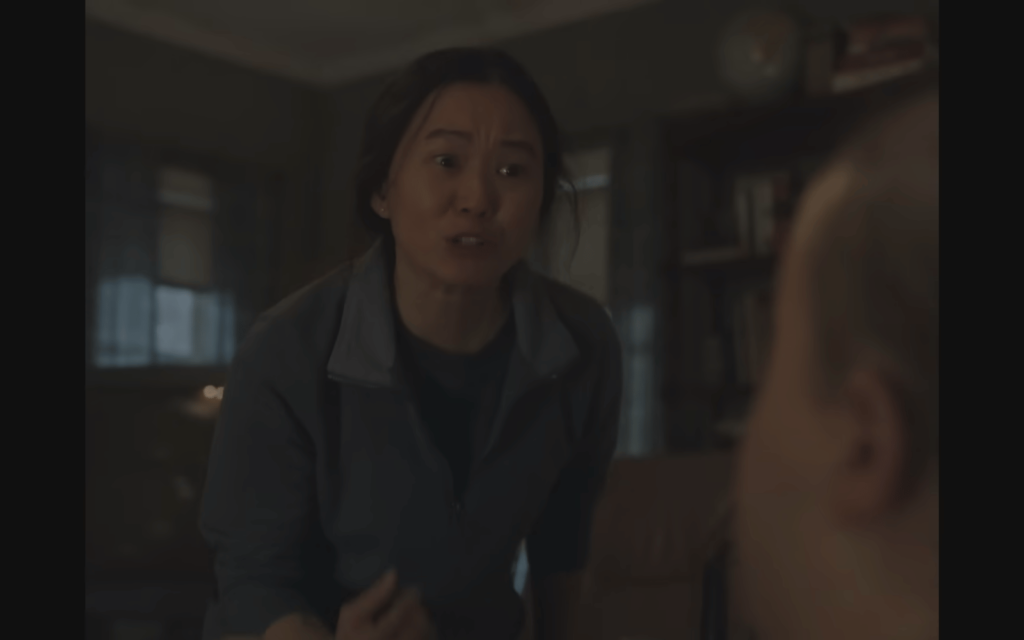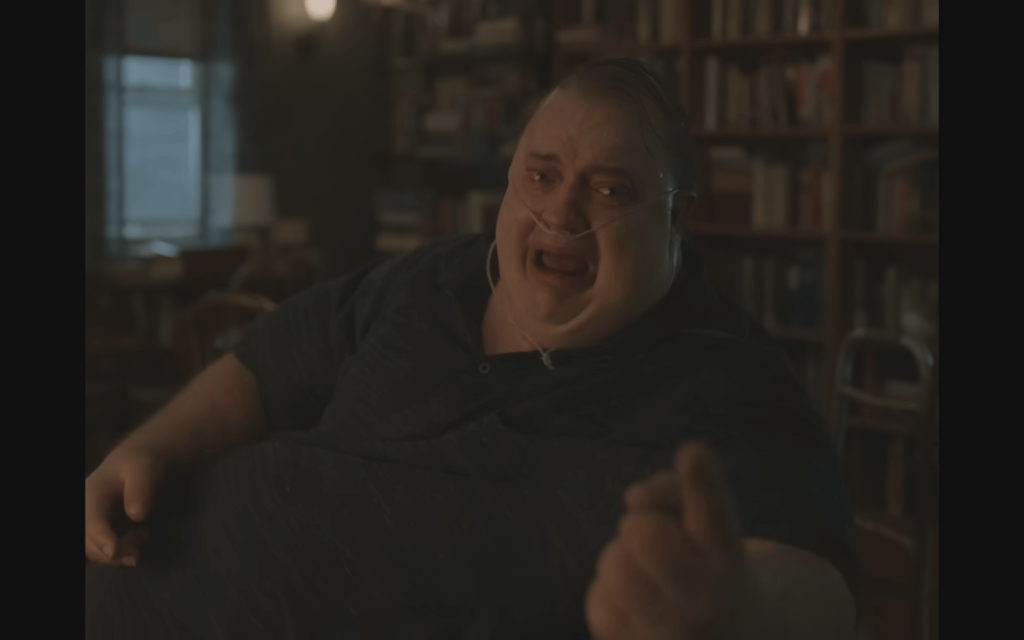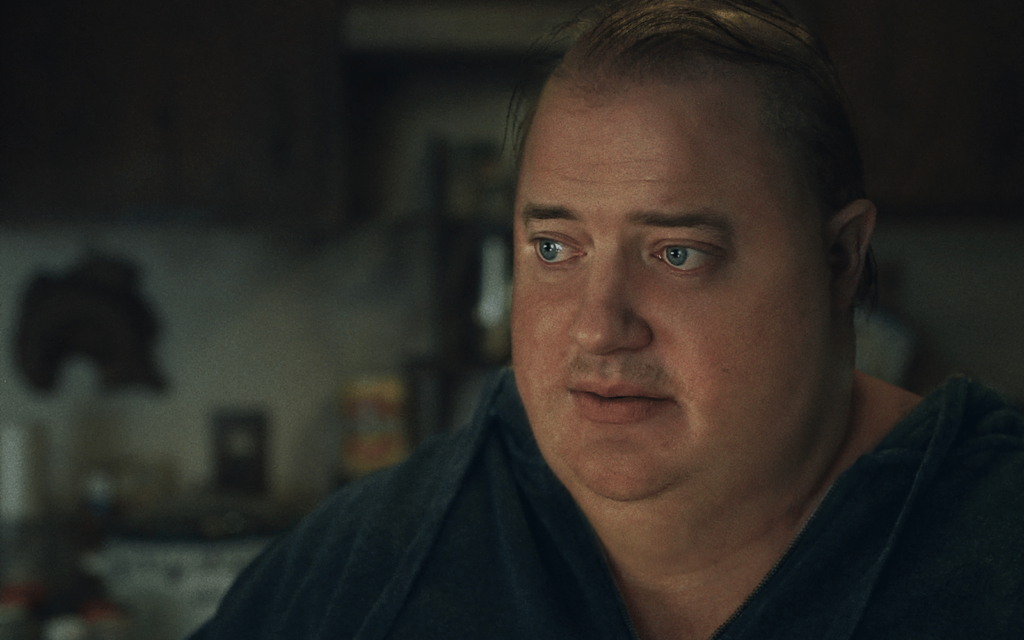A24’s The Whale, from director Darren Aronofsky, marks the unanimously welcomed return of Brendan Fraser to the big screen. He’s joined by a relatively small and mostly effective cast of Hong Chau, Sadie Sink, and Ty Simpkins.
The storyline, based on the stage play of the same name by Samuel D. Hunter, follows Charlie (Fraser), a morbidly obese reclusive English literature teacher. Despite the best efforts of his one and only friend Liz (Chau), Charlie is either unwilling or unable to stop eating himself to death.
With alarmingly high blood pressure and congestive heart failure imminent, Charlie desperately attempts to reconcile with his estranged teenage daughter Ellie (Sink), despite Liz’s reluctance.
Through the film’s roughly two-hour runtime, we learn that Charlie “never used to be this big” and that his condition largely stems from his need to numb the losses of people close to him, his separation from his wife Mary (played by Samantha Morton) and daughter Ellie, and the death of his partner and former student. Charlie does this by binge eating, sometimes to the point that he nearly chokes to death or until he vomits into his bin.

Throughout our viewing of The Whale, we found it difficult not to root for Fraser’s Hollywood comeback. His emotive performance shines through the massive prosthetic body suit that earned him a Best Actor Academy Award nomination and multiple wins in the same category from other awards bodies.
However, we found it far more challenging to watch Charlie absorb cruelty from the few people around him while he knowingly eats himself to death. This apparent fascination with the abject shouldn’t surprise anyone who’s seen Aronofsky’s other notable films, Requiem for a Dream (2000), Black Swan (2010), or Mother! (2017). But what makes The Whale different from those is also its undoing.
A contest of intentions
The Whale is possibly Aronofsky’s most straightforward narrative. It isn’t shrouded in metaphor, a choice that makes it more accessible. After Aronofsky’s trademark fade to white ahead of the credits, you aren’t left with the need to find and understand the possible hidden meaning his other works arouse.
But at the same time, many of the techniques Aronofsky employs are deliberately used to provoke a sense of unease and disgust in the audience. Like how the film’s sound design accentuates Charlie’s binge-eating sessions, through the use of the camera as he struggles to stand without aid or having him constantly drenched in sweat.
This provoking seems to be at odds with the underlying message of the film and something that Charlie firmly believes – people are good, even when they may seem cruel or evil.
Doesn’t make the jump
The film is also let down by Hunter’s screenplay adaptation of his stage play and a few of Aronofsky’s directorial choices. Specifically, it struggles to shake its stage origins. That isn’t always a negative. Aaron Sorkin’s A Few Good Men (1992), Ruben Santiago-Hudson’s Ma Rainey’s Black Bottom (2020), and David Mamet‘s Glengarry Glen Ross (1992) made a successful jump from stage to screen through film adaptations. They also tend to flaunt their stage roots but do so in ways that add to their adaptation – something this film fails to accomplish.
It is contained entirely within Charlie’s two-bedroom apartment save for a few ventures onto his front veranda. And although the cast is relatively small, the space still feels claustrophobic in the way a poorly blocked stage play often does, emphasised by Aronofsky’s use of the almost-square 1.33:1 aspect ratio.
A masterclass from Fraser
Fraser’s compelling portrayal of Charlie, under Aronofsky’s direction, demands that the audience recognise him as more than just a fat person to be pitied. His performance insists we challenge the commonly held notions that obesity is simply a result of a person’s gluttony, laziness, or perceived lack of self-worth. That there may be deeper psychological or emotional reasons that lead to the state we find Charlie in. The authenticity and dignity in the face of ridicule that Fraser imbues in Charlie make that task an easy one.

The same can be said for Chau and Sink with their performances as of Liz and Ellie. Charlie and Liz’s relationship is effortlessly endearing and the most nuanced. From the outset, you can’t help but feel Liz, as a nurse, is partially responsible for allowing Charlie to get to that point. She even serves as his enabler, bringing him buckets of fried chicken or meatball subs. But as you watch the pair interact and learn about the origin of their friendship, that feeling is replaced with empathy.
Other intercharacter relationships feel one-dimensional by comparison, especially the side plot involving Ellie and Simpkins’ character, Thomas, a travelling missionary from a cult-like religious group. Thomas is used as a plot device and swiftly discarded when he is no longer needed. You could remove his inclusion entirely and the story would remain largely unchanged.

As emotionally provocative as Fraser’s performance is, it simply cannot support the film and often seems at odds with it. Added to that are Aronofsky’s contradictory choices. There are moments where he encourages the audience to gawk at Charlie while also rebuking viewers for doing so. This contradiction often leads to a feeling of detachment, undoing Fraser’s hard work to that point.
But if you strip away most of what The Whale attempts to force on the audience and see it instead as a contained character study with a strong lead performance, it’s worth the watch. If for nothing else than to see Brenan Fraser’s return.
The Whale begins its local theatrical release today, 10 February.




